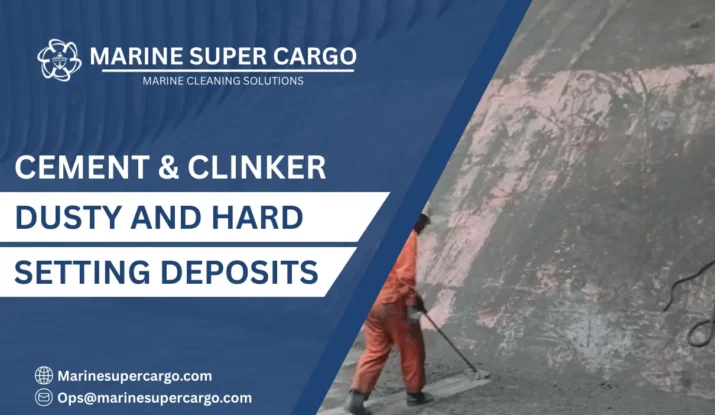Cement and clinker transportation presents unique challenges for bulk carriers, particularly when dealing with dusty and hard setting deposits. These challenging cargoes require specialized cleaning techniques to maintain vessel integrity and comply with international maritime regulations. Cement and clinker dusty and hard setting deposits demand immediate attention to prevent permanent damage to cargo holds.
Understanding Cement and clinker dusty and hard setting deposits
Cement and clinker dusty and hard setting deposits form when moisture infiltrates cargo spaces during transport. These deposits create stubborn residues that adhere to bulkheads, tank tops, and hatch covers. The dusty nature of cement combines with atmospheric moisture, creating concrete-like formations that challenge traditional cleaning methods.
Bulk carriers transporting these materials face significant operational risks. The starboard and port holds often experience different deposit patterns due to vessel movement and weather conditions. Forward holds near the bow typically accumulate more moisture-related deposits than aft compartments near the stern.
Cement and clinker dusty and hard setting deposits require immediate intervention following discharge operations. Delayed cleaning allows these materials to cure, creating permanent structural damage and reducing cargo hold capacity.
MARPOL and IMO Compliance for Cement Transport
The International Maritime Organization (IMO) establishes strict guidelines for bulk carrier operations. MARPOL regulations specifically address waste management during hold cleaning operations involving cement and clinker residues.
Cement and clinker dusty and hard setting deposits cleaning must comply with MARPOL Annex V requirements. All cleaning residues must be properly contained and disposed of according to international waste management protocols. Vessel operators must maintain detailed records of cleaning procedures and waste discharge locations.
Professional Cleaning Solutions by Marine Super Cargo
Marine Super Cargo specializes in addressing Cement and clinker dusty and hard setting deposits through advanced cleaning methodologies. Our experienced teams understand the unique challenges posed by these materials and employ industry-specific techniques.
Our comprehensive approach includes pre-cleaning assessments of all cargo spaces, from bow to stern. We utilize specialized equipment designed for removing hardened cement deposits without damaging vessel structures. The cleaning process addresses both dusty surface deposits and deep-set concrete formations.
Cement and clinker dusty and hard setting deposits removal requires careful coordination between deck crews and cleaning specialists. Marine Super Cargo ensures minimal disruption to vessel schedules while maintaining the highest safety standards.

Technical Challenges and Solutions
Bulk carriers face multiple challenges when dealing with Cement and clinker dusty and hard setting deposits. The dusty particles penetrate ventilation systems, creating respiratory hazards for crew members. Hard setting deposits require mechanical removal, potentially damaging protective coatings on steel surfaces.
Temperature variations between holds create condensation patterns that accelerate cement curing. Port-side holds may experience different deposit characteristics compared to starboard compartments. Forward sections near the forecastle often require more intensive cleaning due to spray exposure.
Professional cleaning services address these challenges through systematic approaches. Water-based cleaning solutions dissolve dusty deposits while mechanical techniques remove hardened formations. Proper ventilation ensures safe working conditions throughout the cleaning process.
Prevention and Maintenance Strategies
Preventing Cement and clinker dusty and hard setting deposits begins with proper hold preparation before loading. Ensuring dry conditions in all cargo spaces minimizes moisture-related curing. Regular inspection of hatch covers and ventilation systems prevents water infiltration during transport.
Crew training plays a crucial role in managing cement cargoes. Understanding the characteristics of Cement and clinker dusty and hard setting deposits enables early intervention when problems arise. Prompt action following discharge prevents costly remedial cleaning operations.
Marine Super Cargo provides comprehensive maintenance programs designed to prevent deposit formation. Our services include hold coating inspections, ventilation system maintenance, and crew training programs.
Industry Best Practices
Maritime industry standards for handling Cement and clinker dusty and hard setting deposits continue evolving. Modern bulk carriers incorporate improved ventilation systems and moisture control technologies. These innovations reduce the likelihood of problematic deposit formation during transport.
Cleaning protocols must address environmental concerns while maintaining operational efficiency. Proper waste containment prevents marine pollution while ensuring vessel readiness for subsequent cargoes. Documentation requirements under IMO regulations demand detailed cleaning records.
Cement and clinker dusty and hard setting deposits management requires coordination between multiple stakeholders. Ship operators, cleaning contractors, and port authorities must collaborate to ensure safe and efficient operations. Marine Super Cargo facilitates this coordination through comprehensive service packages.
Frequently Asked Questions
Q1: How quickly do cement & clinker deposits harden in cargo holds?
A: Cement deposits can begin setting within hours when exposed to moisture. Complete hardening typically occurs within 24-48 hours, making immediate cleaning essential.
Q2: What safety precautions are required during deposit removal?
A: Workers must wear respiratory protection, eye protection, and protective clothing. Proper ventilation and dust suppression measures are mandatory throughout the cleaning process.
Q3: Can hardened cement deposits damage cargo hold structures?
A: Yes, hardened deposits can cause permanent damage to protective coatings and steel surfaces if not properly removed using appropriate techniques.
Q4: How does MARPOL regulation affect cement residue disposal?
A: All cement cleaning residues must be collected and disposed of according to MARPOL Annex V requirements, with proper documentation maintained.
Q5: What preventive measures reduce deposit formation during transport?
A: Maintaining dry hold conditions, ensuring proper hatch sealing, and regular moisture monitoring significantly reduce deposit formation risks.
For professional bulk carrier hold cleaning services specializing in cement & clinker deposits, contact Marine Super Cargo today. Our expert teams ensure MARPOL compliance while maintaining vessel operational efficiency.


